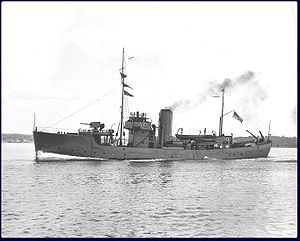HMCS Nootka (J35)

Nootka underway
|
|
| History | |
|---|---|
|
|
|
| Name: | Nootka |
| Namesake: | Nootka Sound |
| Ordered: | 23 August 1937 |
| Builder: | Yarrows Ltd., Esquimalt |
| Laid down: | 1 February 1938 |
| Launched: | 26 September 1938 |
| Commissioned: | 6 December 1938 |
| Decommissioned: | 29 July 1945 |
| Renamed: | Nanoose 1943 |
| Identification: | pennant number: J35 |
| Fate: | Sold for commercial service 1946. |
| General characteristics | |
| Class and type: | Fundy-class minesweeper |
| Displacement: | 460 long tons (470 t; 520 short tons) |
| Length: | 163 ft (49.7 m) |
| Beam: | 27.5 ft (8.4 m) |
| Draught: | 14.5 ft (4.4 m) |
| Speed: | 12 knots (22.2 km/h) |
| Complement: | 38 |
| Armament: | 1 × QF 4 in (102 mm) Mk IV gun |
HMCS Nootka was a Fundy-class minesweeper that served in the Royal Canadian Navy from 1938–1945. She saw service during the Second World War as a local minesweeper working out of Halifax, Nova Scotia. She was named for Nootka Sound. In 1943 she was renamed HMCS Nanoose to allow the unit name Nootka to be used by the destroyer HMCS Nootka. Following the war the ship was sold for mercantile use, becoming the tugboat Sung Ling. The ship's registry was deleted in 1993.
In 1936, new minesweepers were ordered for the Royal Canadian Navy. Based on the British Basset class, those built on the West Coast of Canada would cost $403,000 per vessel. At the outbreak of the Second World War, the Royal Canadian Navy considered constructing more, but chose to build Bangor-class minesweepers instead upon learning of that design due to their oil-burning engines.
The Fundy class, named after the lead ship, displaced 460 long tons (470 t; 520 short tons). They were 163 ft (49.7 m) long, with a beam of 27.5 ft (8.4 m) and a draught of 14.5 ft (4.4 m). They had a complement of 3 officers and 35 ratings.
The Fundy class was propelled by one shaft driven by vertical triple expansion engine powered by steam from a one-cylinder boiler. This created between 850–950 indicated horsepower (630–710 kW) and gave the minesweepers a top speed of 12 knots (22 km/h; 14 mph). The ships were capable of carrying between 180–196 long tons (183–199 t) of coal.
...
Wikipedia
